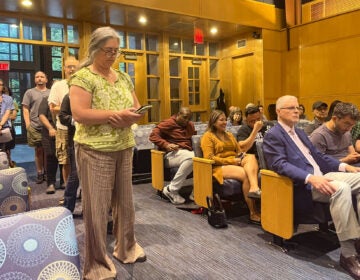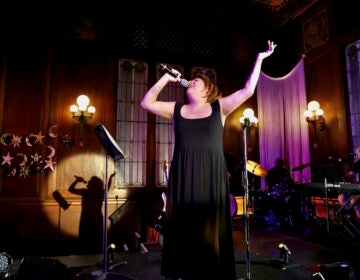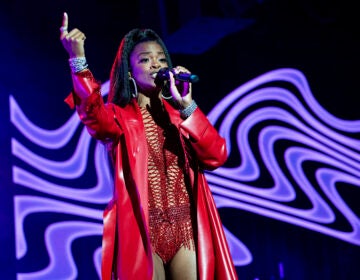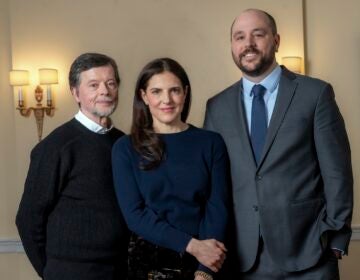Salvador Jiménez-Flores brings ‘playful and provocative’ exhibit to New Jersey’s Grounds for Sculpture
The Chicago-based artist’s newest work is semi-autobiographical while paying homage to the resilience and hope of migrants.
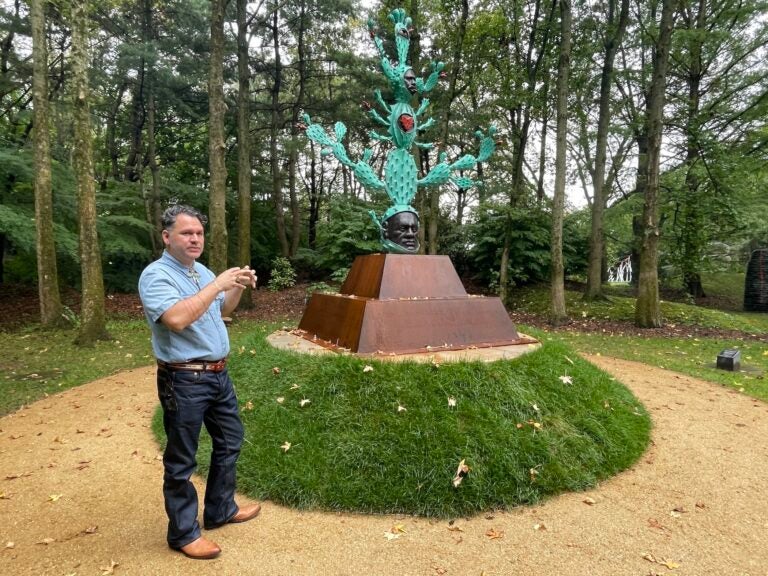
Artist and educator Salvador Jiménez-Flores explains the vision behind a new sculpture commissioned by Grounds for Sculpture in Hamilton, New Jersey. It is called El Susurro del Desierto/The Resistance of the Hybrid Cacti: The Desert's Whisper. (P. Kenneth Burns/WHYY)
Grounds for Sculpture in Hamilton, New Jersey is familiar territory for Salvador Jiménez-Flores. His work was last featured at the museum in a collective exhibition with other artists called “Fragile: Earth” in 2022.
“It does feels like a sense of being familiar to the space,” he said.
The Chicago-based artist and educator is being featured in a new solo exhibition at the museum called “Raíces & Resistencias,” which opens to the public Sunday.
Jiménez-Flores said being familiar with the space also improved how his work turned out.

“I think after spending a few visits in the grounds, it allowed me to think about how the work can best fit in this context,” he said.
The exhibit features three new works that will be on display through August 2027 — two indoor pieces and one bronze sculpture commissioned by the museum to be part of its permanent collection.
“These works speak to the experience of migration and the migrants’ hybrid identities and the idea of resilience, asking us to reflect on the complex and intertwined history of migration and identity at both the individual and the geopolitical level,” said Gary Garrido Schneider, the museum’s executive director.
He described Jiménez-Flores’ work as “both playful and provocative, addressing critical issues of migration, cultural hybridity and resilience.”
Overall, the works by Jiménez-Flores are semiautobiographical in some aspects, while also sharing his view of a complex relationship between the United States, Mexico and South America. Glimmers of hope are built into the exhibit, like a single green leaf that is growing from part of a chain linked fence, echoing the U.S. flag.
He uses the term “revisionist history” to explore the arcs.
“I’m kind of revisiting some of these events that sometimes we don’t talk about this as being part of USA history,” he said. “Now it has my perspective based on my family history, but also my research.”
Jiménez-Flores was born in Mexico and immigrated with his family to Chicago when he was 15. His family has migrated between Mexico and the United States for more than three generations through programs that invited migrant labor.
His great-great-grandfather was one of the Mexican railroad workers, known as traqueros, who were instrumental in building America’s railroad network between 1870 and 1930. Jiménez-Flores referenced that time in a mural on the 80-foot wall in the East Gallery called “Memoria, Tierra, Trabajo: A Glimpse of the Semiquincentennial,” which presents an unfolding timeline and counter-narrative of colonization, labor and migration in the Americas.

The mural also references the United Farm Workers, which connects to his father who was part of the Bracero Program, a former federal program that brought Mexican labor to work on farms.
“Those are two things that I wanted to connect thinking about, like that comes with my migration story and family migration story,” Jiménez-Flores said.

On the opposite wall from the mural is an installation called “Gritos Grabados en la penca del nopal,” where a self-portrait of Jiménez-Flores as a cactus is in the center surrounded by ceramic cactus paddles with declarations made at immigration protests.
The newly commissioned bronze statue is called “La Resistencia de los nopoales híbridos: El Susurro del Desierto/The Resistance of the Hybrid Cacti: The Desert’s Whisper.” It also features a self-portrait of Jiménez-Flores, this time looking into the future while wearing sunglasses.

Jiménez-Flores said self-portraits allowed him to be more playful.
“It just gives you more freedom ‘cause you’re not trying to depict anyone or you’re not hurting anyone’s feelings,” he said. “It’s just kind of like making fun of yourself or kind of like creating these different versions of yourself through the work.”
Jiménez-Flores hopes his exhibit will cause people to reflect on their own experience and think about their own migration story.
“I hope that that would create a little bit more of empathy towards what’s going on currently with the immigration crisis happening in the States,” he said.
WHYY is your source for fact-based, in-depth journalism and information. As a nonprofit organization, we rely on financial support from readers like you. Please give today.



